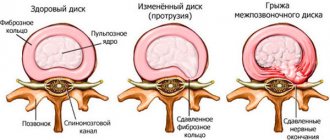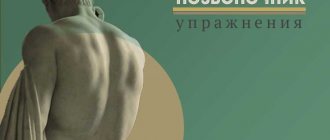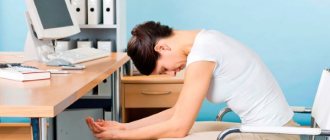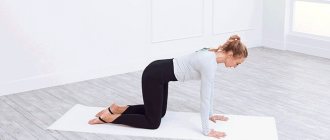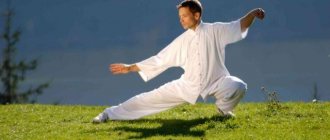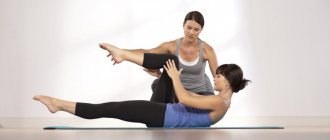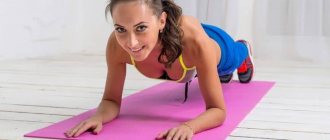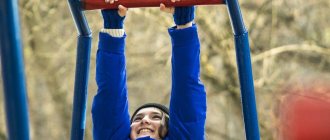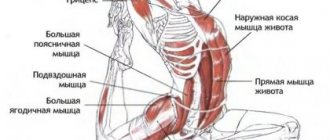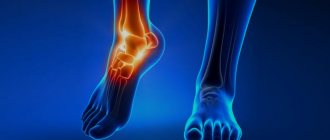Academician Norbekov is widely known throughout the world for his systems for healing the body. His gymnastics for the spine deserve special attention. Norbekov was one of the first who began to treat the disease from the inside, and not just its external symptoms, reaching the very depths in this. Diseases such as osteochondrosis, hernia and other pathologies of the spine are not only a consequence of certain processes in bone tissue, but also malfunctions of the body as a whole. Metabolism and hormonal levels change, stress or depression are possible - all this has a negative impact. Norbekov’s gymnastics for the spine helps eliminate many of these factors, promoting a person’s health and allowing him to find inner harmony.
Gymnastics for the neck spine
Gymnastics of the cervical spine stabilizes the pressure inside the skull, improves visual and auditory qualities, memory, and brain performance.
With constant implementation of a therapeutic complex of physical activity, brain nutrition improves, numbness of the upper extremities stops, the functionality of the thyroid gland stabilizes, and sleep normalizes. We begin strengthening gymnastics by straightening the posture.
Keep your body straight, lower your chin to your chest. We try to lower the chin as close to the chest as possible, while changing the tension to light relaxation, and slowly return to the original position. There should be a feeling of slight tension in the neck area; You should never overexert yourself to the point of pain. We carry out several such manipulations. If you have injuries in the cervical spine or find this exercise too difficult, change it to pulling your head forward.
The body is straight, we tilt our head back a little (so that the chin, as it were, tends upward). We stretch upward, pause the movement for a second, reducing the tension, and again strive in the same direction. We carry out several approaches, not forgetting about pain (it should be absent).
The spine is straight. The shoulders are motionless during this exercise. We tilt our head to the right, without undue tension we try to touch our ear to our shoulder. Then we repeat a similar manipulation, only to the left. Don't worry if the task isn't completed right away; Over time you will be able to do this exercise easily. The main thing is not to overdo it.
We assume a straight body position, head straight, looking ahead. We lower our head to the right and left, while the nose should remain in the center (similar actions can be observed in puppies who see something unusual). We perform this technique in 3 variants:
- the head is level, you just need to look straight;
- the head is lowered, you need to look down;
- The head is slightly thrown back, you need to look up.
You should be extremely careful when performing this exercise.
Let's start with circular movements of the head. We roll it slowly: several times in one direction, and then in the other. The neck muscles should never be stiff. Be sure to evaluate your feelings. If you have pathologies in the neck, then you can only do an incomplete circle, in which there is no bending back. We aim our ear to the right shoulder, point our chin down and smoothly move to the left shoulder.
The stand is level. The head is located on the same vertical line as the spine. Place your right hand on your right temple. Slowly we begin to look away to the right, turning our heads at the same time, and then focus our attention with our hand. Give a little tension, and after that - complete relaxation. Repeat the same manipulations in the other direction. We don’t throw our heads back. The so-called pressure can be done on the frontal part of the head, on the crown and back of the head. The pressure is applied within a few seconds. Exercise stabilizes blood supply and prevents dizziness due to osteochondrosis affecting the cervical spine.
It is important to remember that with all the advantages that Norbekov’s technique has, it is contraindicated for some people
Exercises for the neck for hypertension
For this disease, you should use the following gymnastics:
- straighten and bend your neck as much as possible;
- tilt your head to the sides;
- try to reach your shoulder with your ear;
- make vertical rotational movements forward with your head as if your ears are describing a circle that is located on the side;
- move your head back and forth, using your palm for resistance;
- turn your head to the side with the same resistance;
- try to press your head into your shoulders.
Execution technique
Treatment complex for the cervical spine
In order to stabilize intracranial pressure, improve visual acuity and increase blood supply to the brain, you should perform sports tasks for the neck in 6-12 approaches:
- In a standing position, the spine straightens, the head is thrown back. The chin should be pulled upward, tensing and relaxing the neck muscles.
- The head tilts to the sides and reaches towards the shoulder. The upper part of the body is motionless.
- The neck turns to the side and the chin rises up. This is done in both directions. Then it is performed in the same way, but with the chin stretching down.
- With your head thrown back, your neck turns left and right.
- From a standing position, look away to the side, and behind it turn the cervical spine.
- Tasks from the complex are performed simultaneously with circular movements of the head. To cure cervical osteochondrosis, sudden movements must be avoided.
Exercise for the chest
Norbekov’s gymnastics for the spine with osteochondrosis of the upper part of the body takes a little time - from 30 minutes to 1 hour and includes the following exercises:
- The spine is straightened and the hip part is fixed. The palms are clasped in front of the chest, and the chin is pressed towards the body. Shoulders point inward. Pause for 5-10 seconds. Breathing should be smooth.
- Starting position is standing, palms clasped behind your back. Shoulders should pull back, but not jump up. The shoulder blades are brought together as much as possible, and the chest moves forward and upward.
- Alternately raise one shoulder and lower the other. Fixation in each position for 3-4 s.
- Perform rotational movements of the shoulder joints forward and backward.
- The arm is bent behind the head so that the elbow joint looks up. The gaze stops at the elbow. The muscles are stretched.
- Circular movements of the shoulder joints are performed forward and backward. The effectiveness of the exercise will be indicated by a wave felt throughout the spinal column.
- The palms, clenched into fists, are moved behind the back and fixed on the lower back. Springing with your elbows, you should bring them together.
Warm up the lumbar region
To increase the mobility of the hip joints and relieve pain in the lower spine, it is worth performing the following complex:
- Place your legs apart and bend your knees slightly. The body is fixed. The coccygeal part must make springing upward movements.
- There is a deflection in the lower back, the tailbone reaches towards the head. The spine is straight.
- The spinal column arches. You need to feel how the weight is evenly distributed throughout all departments.
- Rotational movements of the hip joints are performed.
- The hip gives in to the left and forward. Sideways springing movements are shown. Then bend towards the abducted leg.
- The arms are extended as high as possible, and the body is tilted forward. Feet should be together.
- Lean your body forward and bend your knees slightly. Bend in the lumbar region so that the tailbone stretches upward.
Warm-up
Before moving on to gymnastics, you should perform the following exercises:
- raise your arms 90 degrees, clench your hands into fists and unclench them;
- raise your shoulders, round your back, let go;
- Simulate circular movements of your shoulders forward and backward 4 times;
- raise your right hand up and lower your left hand down, pull yourself up a little and raise your arms;
- stand up straight and try to make a figure eight with your hips.
These movements will help prepare and stretch your muscles before exercising.
The essence of Dr. Norbekov’s technique
Interestingly, little is known about Dr. Norbekov until he became famous. The facts of his biography were rarely covered in scientific works and books. It is known that Mirzakarim Sanakulovich was born in 1957 in a mountain village near Samarkand. In 1998, he created the “Institute of Human Self-Healing” in Moscow. The essence of the technique is not only physical activity, but also stabilization of the patient’s psycho-emotional state. Many scientists are skeptical about Norbekov’s methods, but as evidenced by the positive results of patients, gymnastics works. What is its essence:
- methods differ by age and gender;
- only a mentally healthy person can improve his body;
- Norbekov’s gymnastics for the spine is the restoration of health with the help of a person’s internal resources.
The technique is divided into three parts:
- Stimulation of the nervous and circulatory system.
- Working with the inner self.
Gymnastics goal:
- increased self-esteem;
- body control;
- realization of creative possibilities;
- creating a positive mood;
- feeling of health and youth;
- normalization of joint functions;
- restoration of motor activity;
- elimination of pain syndrome;
- normalization of mental state.
All exercises must be performed only in a positive mood, otherwise there will be no results.
It is important to believe in the result
Norbekov notes that during exercises you should concentrate on the part of the spine that is working at the moment.
The system itself is quite accessible and does not pose any harm to health. The exercises can be done safely at home.
About the author of the technique
Most patients who performed the exercises noted positive dynamics after just a few sessions. According to them, constant training improves the functioning of the circulatory system, relieves stiffness and activates muscle function, and promotes rapid recovery from injuries.
To improve your well-being, it is enough to do joint exercises according to Norbekov for 30 minutes a day. Each exercise is performed slowly, smoothly, without sudden movements. The complex of classes includes activities aimed at improving vision, gait, memory and general well-being.
Source
The name of Mirzakarim Sanakulovich Norbekov is known to many. He is the founder of the Institute of Human Self-Healing, an academician and one of the most prominent representatives of alternative medicine.
Joint gymnastics according to Norbekov for the spine is a way to restore health by connecting the body’s internal resources, through self-control and changing, first of all, one’s attitude towards one’s own health.
The history of this method is quite long. The author experienced its effect on himself and was able to get rid of serious kidney disease and a number of other related problems. Over the years of practice, he improved the technique and made it even more effective.
Experts' opinions about Norbekov's gymnastics are divided
Norbekov’s gymnastics for the spine is a component of general joint gymnastics, including exercises for working out almost all joints of the body. The exercises are quite simple, and it is enough to do them a couple of times to remember them.
Exercises make it possible to combat spinal curvature, improve the condition of the intervertebral discs and the functioning of the spinal column as a whole. A healthy spine also has a positive effect on your overall health.
The main objectives of this technique are as follows:
- Achieve control over your body, restoring mobility and a normal rhythm of life.
- Feel the joy of movement and feel healthy and youthful. Loads help you feel a surge of vigor, improve flexibility and plasticity.
- Improve your overall health of the body. The author of the method is confident that the spine is the entrance to the internal system of the human body, through which we can set all the “settings” for health.
Gymnastics consists of two parts:
- the exercises themselves for the joints;
- training of the circulatory and nervous system;
- improving your inner world and increasing self-confidence.
The right attitude is very important. You must believe in your healing. According to the author, this is the main key to success. You must send a signal to your body that exercise will lead to success. This is not easy to achieve, but it is important.
Before you begin the exercises directly, you will need to tune in to them psychologically. The author insists on the importance of conscious implementation. At the same time, you need to understand the structure of the spine.
When working on a specific area, you should concentrate on it as much as possible and not use the rest. Then another department is worked out, and thus all the gymnastics are performed sequentially.
Among the advantages of such a system, it is worth highlighting its accessibility - it does not require any material investments, and you can perform the exercises at home. Plus, it's really effective if you do it right.
The disadvantages include the presence of contraindications. In addition, keep in mind that due to the importance of the psychological factor, a stable nervous system will be required.
Exercises from Vitaly Demyanovich Gitt for cervical osteochondrosis, effectiveness and approximate complex
Most doctors are confident that diseases of the spinal column can only be treated using methods of official medicine. But chiropractor Vitaly Gitt thinks that this is not so.
He is confident that drug therapy can bring temporary improvement in the patient's condition.
Gitta micromovement gymnastics for osteochondrosis normalizes the functioning of the musculoskeletal system and eliminates the causes of its pathologies.
Exercises by V. D. Gitta
The Gitt method for cervical osteochondrosis implies that all exercises throughout the day will be repeated every 60 minutes; if you do the exercise complex once, there will be no positive result.
The exercises included in the complex are:
- Lie on your back with your head on the bolster, tilting it back a little. The essence of the movements is to move the head from one side to the other. The duration of the exercise is not limited in time.
- Sit with a straight back on a chair, place your hands on your knees. Tilt your head down, look forward. Nod your head with a small amplitude, as if saying “yes.” Continue the exercise for 2 minutes.
- The position is the same, but now the head nods from side to side, as if saying “no.” Such micromovements activate the process of restoring the structure of the intervertebral discs.
- Lie on your back, bend your legs at the knee joints. Turn your body one way and then the other.
- During an exacerbation, the following exercise is suitable for performing: sit on a chair with a straight back, keep your head straight and shake your head to the right side, and then to the left.
- Lie on your back, bend your legs and arms along your body. Pull your knees to your stomach and try to touch them with your head. Repeat at least 5 times.
- Lie on your stomach and lower your arms along your body. Raise your shoulders and head, repeat 5-6 times.
If the listed exercises can be done independently, then there is a complex that should be done only under the guidance of a doctor. It includes the following exercises:
- The instructor clasps the patient's head with his palms and bends to one side and then to the other.
- The person tilts his head to one shoulder, then to the other, and the doctor fixes his chin.
- The patient sits on a chair and relaxes his muscles as much as possible, the instructor tilts his head, but no more than 1 cm.
- With two fingers, the doctor applies pressure on the spinous processes at an angle of 45 degrees, and with the other hand he rests his wrist on the back and applies pressure slightly at a slow pace.
Gymnastics for cervical osteochondrosis by Vitaly Gitta is suitable for performing at home, or you can do it at the workplace. For any movements, the range should be small, which is why the complex is called micromovements.
This video demonstrates the technique of performing the exercises.
Goals and effectiveness
Vitaly Demyanovich Gitt’s exercises for cervical osteochondrosis are aimed at making the joints move without experiencing much stress. Micromovements trigger the flow of nutrients into the area of pathological changes.
During the execution of the complex, movements are made with minimal amplitude, so pain and discomfort are eliminated. This complex can be performed even by patients who are unable to move independently. Initially, Gitt envisioned performing exercises on special beds that increase efficiency, but even in the absence of one, positive results can be achieved.
The effectiveness of such charging is as follows:
- The amount of fluid in the intervertebral discs returns to normal.
- Depreciation is normalized.
- The nutrition of cartilage and bone tissue improves.
- Calcium accumulations on the vertebrae disappear.
- Mobility is normalized.
- The intensity of the pain syndrome decreases.
Regular exercises can improve the patient’s well-being and restore spinal mobility.
Contraindications
No matter how safe and effective the treatment method is, you can always name a group of contraindications, in the presence of which it is better to refrain from performing a set of Gitta exercises. It is not recommended to exercise if:
- Osteochondrosis is in the acute stage and is manifested by severe pain and inflammation.
- During exercise, severe pain and discomfort is felt.
- General standing after class only gets worse.
- The doctor prescribed complete rest and complete absence of movement.
Conclusion
Without physical exercise, it is difficult to imagine the treatment of osteochondrosis. And according to reviews from many patients, Gitta exercises simply work wonders.
Consolidating self-massage after gymnastics
After performing any neck exercises, you should resort to a massage, which you can do yourself.
It is an algorithm:
- place your palms on your neck and, pressing lightly, move them from top to bottom;
- massage the neck with your fingers using rotational movements, which should gradually reach the shoulders;
- work with your hands where the shoulders meet the neck.
All movements should be soft and slow.
Exercises for cervical osteochondrosis using the Gitt method
The main symptoms of osteochondrosis of the cervical spine are pain and limitation of movements. In the treatment of degenerative pathology, drugs are used to improve blood circulation.
Patients are advised to undergo regular physical therapy to prevent further progression of the disease. An integral part of treatment is physical education and gymnastics to strengthen the muscle corset.
Despite the irreversibility of destructive changes in the vertebrae, following all medical recommendations allows patients to lead an active lifestyle.
Vitaly Demyanovich Gitt developed his own method for restoring all damaged structures of the cervical spine. Frequent but measured micro-movements help reverse the pathological process. When performing Vitaly Demyanovich Gitt's exercises for cervical osteochondrosis, no medications or physiotherapeutic measures are required.
Basic principles of therapy
The positive result of therapy for pathologies of the musculoskeletal system with physical therapy is achieved mainly by strengthening the muscle corset.
This reduces the load on damaged vertebrae and intervertebral discs, and becomes a kind of prevention of the progression of pathology.
The structural elements of the spine no longer wear out or wear out, but their condition does not improve.
Regular exercises help restore mobility to joints: flexion and extension of the neck, bending and turning the head. These are the exercises that all exercise therapy doctors recommend.
Vitaly Demyanovich Gitt considers this approach to the treatment of cervical osteochondrosis not only ineffective, but also overly dangerous. Yes, a sufficient amount of blood flows to the vertebrae and discs to supply them with nutrients and biologically active substances.
But during turns and tilts, the surfaces of all elements of the cervical spine are subject to excessive loads and, consequently, damage.
V.D. Gitt suggested replacing intense training with repeated micro-movements throughout the day. Slow, barely noticeable shaking of the head will be much more beneficial than vigorous bending and turning. After several weeks of exercise, the condition of the joints improves:
- a sufficient amount of synovial fluid is produced to lubricate the contacting surfaces of the discs and vertebrae;
- overgrown bone tissue is gradually destroyed, and deposited calcium salts are removed from the cervical region;
- the range of movements increases, neck stiffness in the morning disappears;
- painful symptoms no longer bother the person.
An important rule for performing micromovements is the absence of pain. If discomfort appears, then classes should be interrupted. They begin after a few hours, but the frequency of bending or turning the head is reduced
These should be barely noticeable vibrations, however, ensuring the restoration of discs and vertebrae
They begin after a few hours, but the frequency of bending or turning the head is reduced. These should be barely noticeable vibrations, however, ensuring the restoration of discs and vertebrae.
Warm-up
Doctors advise listening to the sensations that arise during training. If after a certain exercise the patient feels significantly better, then it should be performed more often. This also applies to micromovements for warming up:
- sit on a stool, straighten your back, relax, breathe evenly and deeply;
- smoothly raise your shoulders 1-2 cm, hold them slightly in this position, lower them;
- slowly move your shoulders 2-3 cm, first forward, then back;
- place your hands on your knees, palms down, very slowly swing your elbows from side to side;
- smoothly, barely noticeably, shake your shoulders, as if performing circular movements.
Over time, a person is able to exercise in such a way that others simply do not notice it. And at this time, blood is actively flowing to the vertebrae and discs, and tissues affected by osteochondrosis are being restored. After a productive warm-up, you can begin to perform a basic set of exercises.
Causes and risk factors
To develop an adequate treatment strategy for pathology, knowledge of the causes of the disease is of great importance.
Treatment of arthrosis of the big toe joint should begin with eliminating the influence of damaging factors. Arthrosis of the toes occurs due to degenerative processes in the cartilage tissue of the joint. If previously the cause of the pathology was mainly considered to be age-related changes, now the list of reasons leading to wear of cartilage and joint deformation has expanded:
- Anomalies of connective tissue structure. As a result of hereditary disorders, congenital pathologies of the spine and feet appear, which contribute to the occurrence of arthrosis. An effective method of treating scoliosis, flat feet, and hip dysplasia are manual therapy techniques.
- Overweight and obesity. The foot is subject to deformation under extreme load; due to pressure, microcracks form on the cartilage surface, reducing the sliding function. Elimination of this damaging factor requires weight loss measures - diet, increased physical activity.
- Increased physical activity - heavy physical labor, sports activities, exposure to local vibration, etc. The mechanism of occurrence of deforming processes in the cartilage tissue of the joint is similar to the previous point. To prevent arthrosis of the toes, the listed factors should be eliminated.
- Disruption of self-regeneration processes in joint tissues. The causes of this anomaly are varied: inflammatory processes in the body, circulatory disorders, hormonal imbalance. As a result of malnutrition, cartilage tissue becomes thinner, which leads to disruption of the condition and function of the joint. Treatment of the underlying cause reduces the risk of progression of the pathology.
- Impaired production of synovial fluid in the joint. The function of synovial synthesis is influenced by the condition of the joint cartilage. To replenish the composition and volume of synovial fluid, treatment is aimed at restoring fluid volume, synthesizing hyaluronic acid, and stimulating metabolism.
- Post-traumatic disorders.
Arthrosis of the toes also has another name - a disease of ballerinas. This is due to the fact that the impetus for the onset of inflammation inside the joint of the big toe is constant excess load.
The following categories of people are susceptible to the development of this disease:
- Elderly people. Since the causes of arthrosis of the second toe are dystrophic changes in cartilage tissue, as well as local metabolic disorders, this disease occurs more often in older people than others;
- Women who regularly wear uncomfortable high-heeled shoes;
- Persons engaged in heavy physical labor, as well as athletes.
Risk factors include:
- Hereditary predisposition. Regardless of age and gender, a person may experience arthrosis of the joint of the big toe if one of his relatives suffered from the same disease;
- Metabolism problems. Serious metabolic disorders often lead to the development of joint diseases;
- Chronic diseases. The result of severe pathologies such as obesity or diabetes mellitus can be problems with the joints of the legs;
- Previous injuries. Cracks, sprains of tendons, bruises and fractures of the toes can manifest themselves in the form of arthrosis many years later;
- Excessive physical activity. Hard work or improper exercise can negatively affect the condition of the musculoskeletal system;
- Inactivity.
In the International Classification of Diseases, 10th revision (ICD-10), arthrosis received the code M15-M19.
Risk factors for developing arthrosis
Exercises for myopia, farsightedness, glaucoma
As with any method of alternative medicine, people are divided into two camps: those who are categorically against such unmodern methods of treatment, and those who have proven from personal experience that it helps. Likewise, among the numerous reviews of people who have tried eye exercises using the Norbekov system, there are many enthusiastic responses and accusations of the uselessness of the method.
The key points of charging according to Norbekov should be noted:
during exercise you should keep your back straight; the author more than once notes the importance of the muscle corset and spine; be in the mood for a positive result, and what’s even better is to believe that the person is absolutely healthy. A person suffering from myopia sees objects at a distance blurry and well up close, while a person who is farsighted sees objects on the contrary.
The cause of the disease of both is poor focus. Eye gymnastics according to Norbekov trains weakened muscles of the eyeball and adjusts focus
A person suffering from myopia sees objects at a distance blurry and well up close, while a person who is farsighted sees objects clearly, on the contrary. The cause of the disease of both is poor focus. Eye gymnastics according to Norbekov trains weakened muscles of the eyeball and adjusts focus.
The term glaucoma refers to dozens of serious eye diseases, including:
- increased eye pressure;
- eye dysfunction;
- damage to the optic nerve and its possible atrophy.
In some cases, drug treatment is used, sometimes surgery is performed, and there are often cases when the disease is incurable. M. S. Norbekov claims that the gymnastics he developed helps cure eye diseases, and recommends performing exercises for preventive purposes.
During gymnastics, you must follow the principles:
- each finger touch on the eye is performed in a vertical position without rubbing;
- the amount of pressure required is somewhere between a light touch and a painful sensation;
- All movements are made with the pads of the fingers.
After completing the gymnastic complex, a small acupressure facial massage is recommended. Apply gentle pressure along the wings of the nose, along the edge of the hair, pressing on the hollow in the chin area, between the eyebrows and in the temporal part.
Basic principles of Norbekov gymnastics
Speaking about his technique, Norbekov always pays special attention to the psychological state of the patient. Recommendations for preparing for the exercises are as follows:
- You need to throw away any negativity and bring all your feelings into a positive mood. Any gymnastics movement should be performed with a feeling of pleasant relaxation.
- While performing the exercise, you should mentally improve the chosen character trait in yourself, for example, free control of your mood, healthy self-confidence, calmness.
- It is important to avoid performing exercises mechanically and thoughtlessly. Any movement should be aimed at establishing psychological comfort and positive development. Humor in relation to exercise is encouraged.
Norbekov himself characterizes the spine as a passage to the central system that controls the health of the entire body. Therefore, gymnastics also contains exercises aimed at preliminary development of acupuncture points in order to prepare for the main action on the spine.
According to Norbekov, developing spinal mobility can be done at any age. The academician suggests observing the movements of children and comparing them with the lazy lifestyle of people of a more mature age, when most of the time is spent sitting or lying down. The stages of the exercises consist of joint gymnastics, training of the nervous system and blood vessels, and psychological training of one’s self.
Ways to achieve maximum effect from gymnastics
The back exercises proposed by Norbekov are reminiscent of physical therapy and are not extraordinary. The main emphasis is on combining general health exercises with the patient’s emotional mood.
Important! Positive emotions are required for the effectiveness of gymnastics. If necessary, they can be created artificially
You should get rid of excessive seriousness and negative beliefs, mentally remove restrictions from your body caused by poor health, smile and only after that start exercising.
You must also adhere to the following rules:
Don't count on quick results. Gymnastics should be long-term and regular. It takes several weeks to achieve the first successes. It is necessary to overcome natural laziness and gradually move towards the intended goal, performing all the exercises for five days, followed by a two-day rest. During training, automatic movements are not allowed. You should try to feel every movement of your body, praise yourself and try to achieve self-confidence, calmness, determination or any other traits you wish. At the same time, it is necessary to maintain positive emotions. To gradually and correctly load the musculoskeletal system, there is a certain sequence of exercises. It should be followed
An important aspect is breathing technique. It is necessary to observe a certain rhythm: exhale when tense, inhale when relaxing
You should also breathe slowly and infrequently. Any exercise is repeated 8 to 10 times at a rhythm convenient for the person. The duration of the first training should not exceed half an hour with a further increase in time to 1 hour.
Achieving positive results depends not so much on the correct execution of each exercise, but on the good mood of the patient.
Classes should continue for 40 days, including time to study them, after which the patient evaluates his well-being. If there are no proper results, the 40-day course of training is repeated after a week.
Carboxytherapy for the treatment of musculoskeletal diseases
Contraindications
The main contraindications include:
- Acute phase of the disease. During this course of the disease, you should first use medicinal methods and only after changing the phase proceed to exercises.
- Body temperature is above 37 degrees. In this case, the risk of injury increases, because a person with elevated body temperature is not able to control his movements.
- The presence of any tumors in the body.
- Pregnancy . A woman carrying a child has a greater load on her spine than usual.
- Postoperative syndrome.
Set of exercises
All exercises should be performed at a calm pace. The muscles should be relaxed, there should be no jerking or sudden movements.
During exercise, it is important to feel every muscle and joint and understand for what purpose certain exercises are used, and what benefit the body will receive from it. You need to perform each exercise 7-12 times
It is important that all exercises are performed at a calm pace
Warm-up
This is an important part of the training program, as a good warm-up allows you to warm up the muscles and reduce the risk of injury to the ligamentous apparatus.
Table. Warm-up exercises.
| Exercise number | Description |
| Exercise No. 1 | Stretch your hands in front of you and clench them tightly into fists, then quickly unclench them. |
| Exercise No. 2 | Round your upper back and lift both shoulders up (simulating a shrug). Return to starting position. |
| Exercise #3 | Perform rotational movements with the shoulder body: 4 times forward and the same amount back (this is 1 repetition). |
| Exercise #4 | Raise one hand up and place it behind the body, while simultaneously performing the same actions with the second hand, which is located below. Change hand. |
| Exercise #5 | Place your hands on your lower back (lumbar area), spread your legs shoulder-width apart. Perform calm rotational movements with your pelvis, trying to draw a figure 8 with your hips. |
Warm-up is very important
For the neck
Prices for massagers
The following set of exercises is useful for cervical osteochondrosis and other spinal pathologies localized in the cervical vertebrae. You can perform it after waking up or during a break at work to relieve pain and spasm of the neck muscles.
Tilt your head to the side, trying to touch your shoulder with your earlobe
Repeat on the other side.
Repeat the steps described in the previous exercise, but when your ear touches your shoulder, gently press down on your head with your opposite hand (an exercise for stretching the neck muscles). Bend your head forward, trying to reach your chest with your chin (your head is pulled forward behind your chin). Tilt your head back so that your chin “looks” up. Perform rotational movements with your neck and chin in a circle or semicircle. Tilt your head down (chin touching chest). Gently turn your head first to the left, then to the right. throw your head back
In this position, you need to pull your chin up, relaxing and straining your neck muscles.
Norbekov’s joint gymnastics in pictures
For thoracic vertebrae
Such gymnastics is especially useful for children and adolescents, as it allows you to correct the initial stage of scoliosis and prevents curvature of the spine and stooping in childhood.
The following exercises will help prevent slouching
Stretch your arms in front of you and join them (“lock”)
In this position, gently press your hands on each other (you should feel the tension in your back and pectoral muscles). Place your hands behind your back, connect them and in this position squeeze your shoulder blades together as much as possible. Raise one shoulder up, while lowering the other one down. Switch sides. Perform body turns, but in such a way that only the chest and shoulder regions are involved (the pelvis and legs remain motionless). Tilt your body to the side, trying to reach the floor, while at the same time placing your hand behind your head on the opposite side.
Exercises for the thoracic vertebrae
For lumbar vertebrae
The exercises below are useful not only for improving the health of the spine, but also for preventing pathologies of the pelvic organs, which are attached to large vertebral joints. Such gymnastics is useful for pyelonephritis, cystitis, weakening of the pelvic muscles, as well as chronic constipation associated with circulatory failure in this part of the body.
- Perform body turns in different directions (the angle of movement should be 180°).
- Bend your lower back forward, trying to stretch your tailbone up as much as possible, while keeping your body in a stationary position.
- Lean forward and completely relax. Round the spine so that it resembles an arch. Stay in this position for at least 1 minute.
- While standing, perform wave-like movements with your torso, moving from the chin to the knee joints.
- Sitting on the floor in a Turkish position, swing your body in different directions (imitate the movements of a pendulum).
Exercises for the lumbar region
Prices for orthopedic sports shoes
Regular performance of these exercises will increase the flexibility of the spine, the elasticity of the muscles that support the spinal joints, improve mood and normalize the functioning of internal organs. Chronic back pain, according to the author, completely disappears after a month of such exercises.
How to make training effective: training rules
The set of exercises includes successive stretching movements that primarily affect the joints. They also train:
- blood vessels;
- nervous system;
- strength of spirit.
Immediately before training aimed at treating the spine, it is necessary to massage the ears for a certain period of time. The presence of biologically active points on them has a beneficial effect on a person’s overall well-being and helps to achieve the necessary psychological state.
Massage of the paranasal area and chin has a similar effect.
There are numerous books by M. Norbekov that allow you to independently master gymnastics for the spine for the purpose of its further use. If you wish, you can sign up for group classes
The warm-up doesn't end there.
You should perform rotational movements with your hands, as well as with your arms at the elbow and shoulder joints. Clench and unclench your fists. Raise and lower your shoulders.
In order for exercises for the spine to be not only effective, but also safe, you must adhere to certain rules. Norbekov recommends doing exercises for the back and the whole body every day, devoting at least 20-30 minutes a day to training, but an important condition for the formation of positive dynamics is the absence of a stress factor during exercise and a good mood. You need to start training only in a good mood.
Who are the classes indicated for and the main contraindications
The audience at Norbekov’s trainings is diverse, there are no age or social restrictions. Anyone who wants to get rid of the disease can come (and can contribute a certain amount of money).
Indications for classes:
- Myopia and farsightedness. Even if vision does not become “eagle-like”, the process of pathology development will slow down.
- Diagnoses of “cataract” and “glaucoma” - gymnastics is considered as one of the means of complex treatment.
- Diagnoses of astigmatism and strabismus.
- Diagnosis of optic nerve atrophy.
The entire system is built on the unity of the emotional, physical and mental principles. Exercise is associated with improved mental health.
Like any health program, Norbekov’s technique has contraindications.
Classes are not allowed for:
- pregnant women;
- for people with a history of identified, suspected epilepsy or predisposition to it;
- those suffering from chronic alcoholism;
- those suffering from drug addiction;
- people who have had a heart attack or stroke;
- patients suffering from mental disorders;
- unbalanced people prone to hysteria.
Cervical region
You should know! The neck is the most mobile part of the spinal column. Malfunctions in its functioning provoke headaches and have a negative effect on the brain and spinal cord.
Gymnastics for the cervical spine promotes:
- stabilization of intracranial pressure;
- improving vision, hearing, memory, functional abilities of the brain;
- normalization of sleep;
- eliminating hand numbness;
- restoration of thyroid functionality;
- improving brain nutrition.
When performing all exercises for the neck, the body position should be straight.
Tilt your chin forward, bringing it as close as possible to your chest with alternate tension and relaxation.
Tilt your head back with your chin up, alternately tensing and relaxing.
Without moving your shoulders, tilt your head to the right and left. Try to reach your ears with your shoulders.
Lift your chin up. Without straining, turn your head left and right. Perform similar movements by tilting your chin.
Direct your gaze to the right with a gradual turn of your head. Make identical movements to the left.
Finally, at a slow pace, you should perform circular movements with your head.
VSD 8212 neck exercises
I wrote about the enormous importance the condition of the neck plays for our health in a previous post. Those who read it carefully understood that sometimes it is cervical osteochondrosis that is the cause of VSD. Let me remind you once again that blood vessels pass through the vertebrae of the cervical spine, which feed our “command post” called the #171;brain#187;, but if, as a result of incorrect posture or due to microspasms of the neck muscles, the blood vessels are pinched, then this is fraught with either increased or decreased intracranial pressure. Due to a lack of oxygen supply to the brain, a multiple bouquet of diseases, symptoms and discomfort appears.
“Any changes in the cervical spine invariably cause changes (curvatures) in both the thoracic and lumbar spine.”
The typical posture of a person with cervical osteochondrosis is symbolically similar to the letter S. The head and neck are protruded forward, and the shoulders are usually raised and constantly tense. Due to the fact that cervical osteochondrosis is closely related (and sometimes is the root cause of poor posture) with other parts of the spine, in order to align the position of the vertebrae in the cervical region, it is necessary to simultaneously align the vertebrae in the lumbar region.
A set of exercises for the neck
Daily neck exercises:
- For 10 - 15 seconds, lying on your back, press the back of your head onto the pillow, while your neck should tense, and do not hold your breath. The same thing, but we lie on our stomachs and press our foreheads onto the pillow. With this exercise we strengthen the neck muscles that hold the head in the correct position.
- We lie on our stomach, hanging our head off the bed, after which we raise our head parallel to the floor and hold it for 10-15 seconds, after which we do the same, first on the left, then on the right side.
- Exercise “Pinocchio”: Standing, back straight, shoulders motionless, neck stretched forward, parallel to the floor. Move your chin up and to the side, first to the left, then to the right, as if your nose #8212; the key and you turn it in the keyhole, first to the left, then to the right. With this exercise, the vertebrae of the neck fall into place, the clamps are removed, and the mobility of the vertebrae increases.
- Standing. We rotate our heads in a circular motion with maximum amplitude, first clockwise, then counterclockwise.
- Standing. Turn your head left and right at an average pace, turning your head as far as possible, trying to look over your shoulder.
- Standing or sitting. We lower our head, touching our chest, trying to reach our chin as low as possible. We fix the lowest point for a few seconds.
- Raise your right hand up over your side, behind your head, and try to reach your left ear. After which we repeat the same thing, but with the left hand.
- We rotate our shoulders in a circular motion, first forward and then back. And so on 5 times back and forth.
- Exercise “Pinocchio” #8212; described above
- Press your forehead onto your palm, and your palm onto your forehead.
- The same thing, but on the back of the head
- While standing, stretch your spine up, and with it your neck up, as if you were being forcefully pulled by the top of your head.
- Standing on our hands and knees, we bend and arch our back - make a “cat”
- Exercise "Cobra". Do not do it at night #8212; tones you up, you may not fall asleep. There are contraindications.
Exercises for the lumbar region:
- Deflections of the spine in the lower back: to the side, first to the left, then to the right (5 times each)
- Deflections of the spine in the lower back: forward, backward (5 times each)
- Twists in the lumbar region. We do it smoothly, with maximum amplitude, but without allowing pain.
- To strengthen the back, we pump with simple exercises, without weights, preferably with bent legs, so as not to overdo it (gradually, starting with 5 times, and then increasing the number of approaches) the abdominal muscles and spine. You can use: a simple floor, a wall bars or an Evminov board.
- For the prevention and treatment of scoliosis, and simply for removing blocks from the vertebrae in the lumbar region, I recommend taking a closer look at the following exercises:
And finally, a few key points for VSD and cervical osteochondrosis:
- First of all, I advise you to familiarize yourself with the general rules for providing exercises from VSD #8212; read #171;Charging from VSD#187;
- Kuznetsov’s applicators, and especially Lyapko’s, perfectly relieve spasms and swelling of any part of the spine
- Try to sit at the computer less
- When working sedentarily, try to change your body position more often and periodically shift the center of gravity of your neck
- Do a self-massage of your neck (just rub the back of your neck)
- And most importantly #8212; This is constant monitoring of correct posture.
Time frame for achieving results
Relief of symptoms is noted after the first set of exercises. However, in order to achieve lasting results, you should perform gymnastics daily for at least one month.
If problems associated with the cervical spine manifest themselves as unpleasant symptoms, then it is not necessary to use drug treatments. You can use gymnastics that were developed by such famous doctors as Shishonin, Baranov, Dikul. To perform these exercises correctly, you should use videos and recommendations from the authors of the methods.
Article design: Vladimir the Great
https://youtu.be/mBk7a1ajSFQ
Thoracic region
The thoracic spine is an element of the rib cage, which is the frame for the heart and lungs and other internal organs.
Significant mobility of the thoracic region provides chest excursions necessary for breathing.
With pathological changes in the bone and cartilaginous tissues of the thoracic region, the vertebrae, joints, intervertebral discs are subject to deformation, and the spinal column changes shape. These processes are accompanied by pain, fatigue, difficulty breathing, and changes in posture.
While sitting on a chair (the chair should have a back that ends near the shoulder blades), clasp your hands behind the back of your head. As you exhale, gently arch your back, while inhaling, return to the starting position.
The movements are similar to those described above, but do not involve joining the hands. You should lean forward with further arching of your back back.
Lie on your back. While inhaling, bend over as much as possible, while raising your torso, and while exhaling, return to the starting position.
You should not be upset if any movement did not work out the first time. Only complete self-confidence, faith in victory and a good mood will help you achieve your cherished goal.
Results and effectiveness of the technique
The effect of the exercises should not be expected a few days after the start of exercise. The minimum duration of the course should be 4 weeks. But the author of the method claims that lasting results can only be obtained with regular training and following a diet.
Norbekov is the author of a unique technique, thanks to which many patients get rid of pathologies of the musculoskeletal system.
Norbekov’s gymnastics for the spine and joints is considered the most popular and effective today, and is therefore used by patients all over the world.
Source
Rules
- It should be noted that when performing exercises with the spine, 99% is the work of the internal state and only 1% is the execution technique.
- When performing exercises, it is necessary to create a good mood (even if it is an artificially created mood). All exercises are performed with joy, a smile and pleasure - this is a prerequisite!
- Exercises are performed every day.
- The enemy of the set of exercises according to Norbekov is automatism, mechanical execution.
Results and effectiveness of the technique
Norbekov (gymnastics for the spine from the author is often the only method of treating spinal pathologies at the initial stage) draws the attention of patients to the fact that in order to consolidate the result, it is important to exercise daily. In addition, you need to tune in to the positive effect of the classes.
The specialist also recommends consolidating the results of training with proper nutrition, especially if you are overweight. You should increase the amount of vegetables, fruits and cereals in the menu. It is useful to consume fermented milk products, dried fruits, and first courses.
It is necessary to exclude confectionery products, smoked meats, baked goods and fatty foods from the diet. In addition, portions should be small and meals should be frequent. You should drink more fluids, but avoid alcohol, carbonated drinks and coffee.
Source

